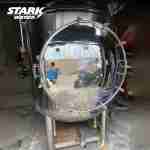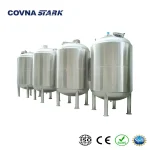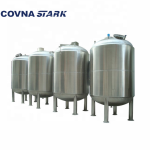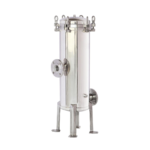The Ultimate B2B Guide to Stainless Steel Water Tanks: Durability, Purity, and Performance
In the demanding world of industrial operations and commercial enterprises, reliable water storage is not just a convenience—it's a critical necessity. The integrity of processes, the quality of products, and the efficiency of operations often hinge on the availability of properly stored water. Among the various storage solutions, stainless steel water tanks have emerged as a premier choice for businesses prioritizing durability, hygiene, and long-term value. This guide offers an in-depth exploration of stainless steel water storage tanks, specifically for a B2B audience including plant managers, engineers, procurement specialists, and distributors.
A stainless steel water tank is more than just a container; it's an engineered solution designed to safeguard water quality and provide dependable service for years, often decades. Whether for potable water, high-purity process water, treated effluent, or even certain chemicals, these tanks offer a superior alternative to other materials. This article will delve into the core benefits, key features, types, selection criteria, applications, and maintenance of stainless steel water storage tank systems, equipping you with the knowledge to make informed decisions for your facility or your clients.
What is a Stainless Steel Water Tank?
A stainless steel water tank is a storage vessel constructed primarily from stainless steel alloys, designed to hold and store water or other compatible liquids. Stainless steel is an iron-based alloy containing a minimum of approximately 10.5% chromium. This chromium content forms a passive, self-repairing oxide layer on the surface, which provides its characteristic corrosion resistance and "stainless" quality.
These tanks are utilized in a vast array of applications, from storing drinking water and food-grade liquids to holding industrial process water, fire suppression water, and even mildly corrosive chemicals. The inherent properties of stainless steel make it an ideal material for applications where hygiene, purity, and resistance to contamination are paramount.
Why Choose Stainless Steel Water Storage Tanks for B2B Applications?
The decision to invest in a stainless steel water storage tank for industrial or commercial use is driven by a compelling set of advantages over other materials like carbon steel, plastic, or concrete:
- Exceptional Durability and Longevity: Stainless steel is renowned for its strength and resistance to wear and tear, ensuring a very long service life, often exceeding 30-50 years with proper maintenance. This makes it a cost-effective solution in the long run.
- Superior Corrosion Resistance: Different grades of stainless steel offer varying levels of corrosion resistance, making them suitable for a wide range of water qualities and environmental conditions. This prevents contamination from rust and material degradation.
- Hygienic Properties and Water Quality Preservation: The smooth, non-porous surface of stainless steel inhibits bacterial growth and biofilm formation, making it easier to clean and maintain water purity. It does not leach chemicals or impart taste or odor to the stored water, crucial for potable water and sensitive industrial processes.
- Low Maintenance Requirements: Compared to tanks made from other materials that may require periodic relining, painting, or extensive repairs, stainless steel tanks generally require minimal maintenance, reducing downtime and operational costs.
- Strength-to-Weight Ratio: Stainless steel offers excellent structural strength, allowing for the construction of large-capacity tanks that are relatively lighter than concrete equivalents, potentially reducing foundation costs.
- Temperature Resistance: Stainless steel can withstand a wide range of temperatures, from cryogenic to elevated, without losing its structural integrity or leaching harmful substances.
- Aesthetic Appeal: Stainless steel tanks often have a clean, modern appearance that can be desirable in visible installations.
- Sustainability and Recyclability: Stainless steel is 100% recyclable at the end of its service life, making it an environmentally responsible choice. Its long lifespan also means fewer replacements and less resource consumption over time.
Key Features and Types of Stainless Steel Water Tanks
Stainless steel water tank systems come in various forms, each with specific features catering to different needs:
1. Material Grades – The Foundation of Performance
The choice of stainless steel grade is critical and depends on the application, water quality (especially chloride content), and environmental conditions:
- Grade 304/304L: The most common general-purpose austenitic stainless steel. Offers good corrosion resistance for most potable water and many industrial applications. 304L has lower carbon content for better weldability and reduced risk of sensitization.
- Grade 316/316L: Contains molybdenum, which significantly enhances corrosion resistance, particularly against chlorides and pitting. Ideal for coastal areas, brackish water, deionized water, and mildly corrosive chemical storage. 316L is the low-carbon version.
- Duplex Stainless Steels (e.g., 2205): Offer higher strength and excellent resistance to stress corrosion cracking, pitting, and crevice corrosion. Often used in more demanding environments or for larger tanks where higher strength is beneficial.
2. Construction Types
- Welded Stainless Steel Tanks: Factory-welded or site-erected by welding. Offer a seamless, leak-proof construction. Suitable for a wide range of sizes.
- Bolted Stainless Steel Tanks (Panel Tanks): Constructed from prefabricated stainless steel panels that are bolted together on-site with gaskets to ensure a watertight seal. Ideal for restricted access locations or when very large capacities are needed, as panels can be easily transported.
- Modular Stainless Steel Tanks: Often a variation of panel tanks, emphasizing standardized modules for flexible configurations and future expansion.
3. Shapes and Designs
- Cylindrical Tanks: Can be vertical (most common for large capacities) or horizontal (often for smaller capacities or specific process needs).
- Rectangular Tanks: Efficient for space utilization, especially indoors or in confined areas. Often used for smaller to medium capacities.
- Elevated Tanks: Provide gravity-fed water pressure, commonly used in municipal water systems or for fire protection.
- Custom Designs: Tanks can be custom-fabricated to meet specific dimensional or process integration requirements.
4. Capacity and Sizing
Stainless steel tanks are available in a vast range of capacities, from a few hundred gallons for small commercial applications to millions of gallons for large industrial or municipal storage.
5. Insulation and Heating/Cooling Options
- Insulation: Polyurethane foam or mineral wool insulation can be applied to maintain water temperature, prevent freezing in cold climates, or reduce heat gain in hot environments. Cladding (e.g., aluminum or stainless steel sheathing) protects the insulation.
- Heating/Cooling Coils/Jackets: For applications requiring precise temperature control of the stored liquid.
Critical Factors for Selecting the Right Stainless Steel Water Tank
Choosing the optimal stainless steel water storage tank involves a thorough assessment of several factors:
- Application and Stored Liquid: Clearly define the purpose. Is it for potable water, demineralized process water, fire suppression, or chemical storage? The nature of the liquid (pH, temperature, chemical composition, chloride levels) is paramount for material selection.
- Required Capacity: Determine the necessary storage volume based on demand, refill rates, and emergency storage needs. Consider future expansion.
- Material Grade Selection: This is crucial. Consult with material experts or experienced tank manufacturers. Over-specifying can be costly, while under-specifying can lead to premature failure. A water analysis is often recommended.
- Design Standards and Certifications: Ensure the tank is designed and fabricated to relevant industry standards. For potable water, NSF/ANSI/CAN 61 certification is essential in North America. Other standards like AWWA D103 (for bolted tanks), API 650 (for welded tanks), or specific industry codes may apply.
- Site Conditions:
- Location: Indoor or outdoor? Exposure to corrosive atmospheres (e.g., coastal, industrial)?
- Space Availability: Dictates shape and orientation.
- Foundation Requirements: Especially for large tanks.
- Seismic Zone: May require specific design considerations for earthquake resistance.
- Nozzles, Fittings, and Accessories: Specify requirements for inlets, outlets, drains, vents, overflows, manways (for access and inspection), level indicators, ladders, and platforms.
- Budget and Total Cost of Ownership (TCO): While stainless steel tanks may have a higher initial cost than some alternatives, their longevity and low maintenance often result in a lower TCO.
- Supplier Reputation and Warranty: Choose a reputable manufacturer or supplier with proven experience in designing and fabricating stainless steel tanks for similar applications. Inquire about warranties.
Diverse Industrial Applications of Stainless Steel Water Tanks
The versatility and reliability of stainless steel water tanks make them suitable for a broad spectrum of B2B applications:
- Food & Beverage Processing: Storing ingredient water, product water, cleaning-in-place (CIP) solutions. The hygienic properties are vital.
- Pharmaceuticals & Biotechnology: Holding Purified Water (PW), Water for Injection (WFI), and other high-purity liquids where preventing contamination is critical. Often require electropolished internal surfaces.
- Chemical Industry: Storing various chemicals, solvents, and process intermediates, provided the stainless steel grade is compatible.
- General Manufacturing: Process water storage, cooling tower make-up, boiler feedwater tanks.
- Municipal Water & Wastewater: Potable water storage, treated effluent storage, process tanks in water and wastewater treatment plants.
- Hospitals & Healthcare Facilities: Storing potable water, hot water, and water for specialized medical equipment.
- Agriculture & Wineries: Irrigation water, livestock drinking water, wine fermentation and storage tanks.
- Fire Protection Systems: Dedicated storage for fire sprinkler systems.
- Data Centers: Cooling water storage for critical infrastructure.
- Breweries and Distilleries: Hot liquor tanks, cold liquor tanks, fermentation vessels.
Maintenance and Care for Stainless Steel Water Tanks
While low-maintenance, stainless steel tanks benefit from periodic attention to ensure optimal performance and longevity:
- Regular Visual Inspection: Check for any signs of leaks, external damage, or issues with fittings and accessories.
- Periodic Cleaning and Sanitization: The frequency depends on the application and water quality. For potable water, follow local health guidelines. Use appropriate cleaning agents compatible with stainless steel.
- Passivation: For new tanks or after certain repairs/modifications, passivation (a chemical treatment to enhance the passive oxide layer) may be recommended, especially for critical applications.
- Avoid Contamination: Do not use carbon steel tools or allow prolonged contact with ferrous materials, as this can lead to "iron contamination" and localized corrosion.
- Monitor Water Chemistry: For industrial processes, ensure the stored water chemistry remains within the design parameters for the chosen stainless steel grade.
Conclusion: A Lasting Investment in Water Storage Excellence
A stainless steel water tank represents a significant, long-term investment in reliable and hygienic water storage. Their inherent durability, superior corrosion resistance, and low maintenance needs make them an economically sound and operationally smart choice for a wide array of B2B applications. By carefully considering the specific requirements of your application, selecting the appropriate material grade and design, and partnering with a reputable supplier, you can ensure your stainless steel water storage tank provides decades of trouble-free service, safeguarding your water quality and supporting your operational success.
If your facility demands the best in water storage, explore our extensive range of high-quality stainless steel water tank solutions. For expert advice and customized configurations tailored to your unique needs, contact our specialists today.





